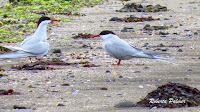ARCTIC TERN
ARCTIC TERN – (Sterna paradisaea) – (See images below)
DESCRIPTION: The Arctic tern is medium grey on top with a black head cap and nape, and has white under parts. The long pointed wings extend almost to the tip of the deeply forked tail, and the primaries have blackish ends, visible in flight. The bill and legs are red in the adults, black in the juveniles. Sexes are similar, and winter plumage doesn’t change much, except for less white on the forehead. This bird is around 30 cm (12 in.) long.
VOICE: https://www.xeno-canto.org/species/Sterna-paradisaea
NAME: The English name ‘Tern’ comes from Old English ‘Stearn’ to designate that bird. As for the Latin name ‘paradisaea’, which means ‘paradise’, it is usually attributed to the Birds of Paradise. The bird’s Latin name attributor, bishop and historian Erik Pontopiddan, perhaps thought that ‘so beautiful a creature belonged in that perfect home beyond the sky’ (personal communication). Although many bird species include subspecies, there are no known ones so far for the Arctic tern.
HABITAT: tundra, open boreal forest edges, bodies of water near the ocean such as estuaries and bays, also sand bars and small islands. and includes the boreal forest, the tundra, rocky islands and beaches.
DIET: Arctic terns feed on small crustaceans and insects, in addition to fish. They usually dive near the water surface, but they may also catch insects on the fly.
NESTING: This species breeds in large colonies on the tundra along Arctic coasts. The nest is a depression on the ground. Between one and three light beige eggs are laid, incubated by both parents, who also both feed the chicks. Parents are aggressively defensive of their nests, and will not hesitate to attack large predators (including humans).
DISTRIBUTION: The main breeding range of the Arctic tern is located in the Arctic. The Arctic tern, as its English name implies, is found in the Arctic around the globe, and spends its summers around the Antarctic.
DISTRIBUTION MAP: https://en.wikipedia.org/wiki/Arctic_tern#/media/File:Sterna_paradisaea_distribution_and_migration_map.png
ON PEI: Although the Arctic tern does breed on Prince Edward Island on the north shore, its occurrence on the island is considered as rare as this province is the southernmost part of its breeding range.
SIMILAR SPECIES: Common tern. Here are some differences however: the common tern red bill has a dark tip, its legs are longer, and the tail is shorter.
NOTES: The arctic tern has the longest migration of any bird species, up to 90 000 km (56,000 mi.) in one year!! This tern also has a very long life span in spite of being such an extensive traveler, up to some 30 years.
REFERENCES: https://en.wikipedia.org/wiki/Arctic_tern
https://www.allaboutbirds.org/guide/Arctic_Tern/lifehistory
https://www.audubon.org/field-guide/bird/arctic-tern
http://www.arkive.org/arctic-tern/sterna-paradisaea/
https://coolantarctica.com/Antarctica%20fact%20file/wildlife/Arctic_animals/arctic_tern.php
http://www.npolar.no/en/species/arctic-tern.html (Norwegian Polar Institute)
Arctic Tern (.pdf document, Alaska Fish and Wildlife Service)
http://www.birdweb.org/Birdweb/bird/arctic_tern
DESCRIPTION: The Arctic tern is medium grey on top with a black head cap and nape, and has white under parts. The long pointed wings extend almost to the tip of the deeply forked tail, and the primaries have blackish ends, visible in flight. The bill and legs are red in the adults, black in the juveniles. Sexes are similar, and winter plumage doesn’t change much, except for less white on the forehead. This bird is around 30 cm (12 in.) long.
VOICE: https://www.xeno-canto.org/species/Sterna-paradisaea
NAME: The English name ‘Tern’ comes from Old English ‘Stearn’ to designate that bird. As for the Latin name ‘paradisaea’, which means ‘paradise’, it is usually attributed to the Birds of Paradise. The bird’s Latin name attributor, bishop and historian Erik Pontopiddan, perhaps thought that ‘so beautiful a creature belonged in that perfect home beyond the sky’ (personal communication). Although many bird species include subspecies, there are no known ones so far for the Arctic tern.
HABITAT: tundra, open boreal forest edges, bodies of water near the ocean such as estuaries and bays, also sand bars and small islands. and includes the boreal forest, the tundra, rocky islands and beaches.
DIET: Arctic terns feed on small crustaceans and insects, in addition to fish. They usually dive near the water surface, but they may also catch insects on the fly.
NESTING: This species breeds in large colonies on the tundra along Arctic coasts. The nest is a depression on the ground. Between one and three light beige eggs are laid, incubated by both parents, who also both feed the chicks. Parents are aggressively defensive of their nests, and will not hesitate to attack large predators (including humans).
DISTRIBUTION: The main breeding range of the Arctic tern is located in the Arctic. The Arctic tern, as its English name implies, is found in the Arctic around the globe, and spends its summers around the Antarctic.
DISTRIBUTION MAP: https://en.wikipedia.org/wiki/Arctic_tern#/media/File:Sterna_paradisaea_distribution_and_migration_map.png
ON PEI: Although the Arctic tern does breed on Prince Edward Island on the north shore, its occurrence on the island is considered as rare as this province is the southernmost part of its breeding range.
SIMILAR SPECIES: Common tern. Here are some differences however: the common tern red bill has a dark tip, its legs are longer, and the tail is shorter.
NOTES: The arctic tern has the longest migration of any bird species, up to 90 000 km (56,000 mi.) in one year!! This tern also has a very long life span in spite of being such an extensive traveler, up to some 30 years.
REFERENCES: https://en.wikipedia.org/wiki/Arctic_tern
https://www.allaboutbirds.org/guide/Arctic_Tern/lifehistory
https://www.audubon.org/field-guide/bird/arctic-tern
http://www.arkive.org/arctic-tern/sterna-paradisaea/
https://coolantarctica.com/Antarctica%20fact%20file/wildlife/Arctic_animals/arctic_tern.php
http://www.npolar.no/en/species/arctic-tern.html (Norwegian Polar Institute)
Arctic Tern (.pdf document, Alaska Fish and Wildlife Service)
http://www.birdweb.org/Birdweb/bird/arctic_tern
 |
| Arctic tern, Iceland, by Roberta Palmer |
 |
| Arctic terns, Iceland, by Roberta Palmer |
 |
| Arctic tern on nest, by Dirk Ingo Franke |
 |
| Can you see the Arctic tern chick? photo by Gordon E. Robertson |
 |
| Arctic tern on Farne Island, Jamuniwa |